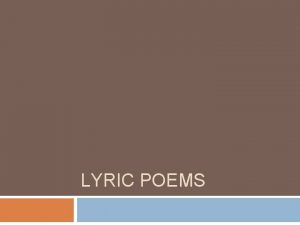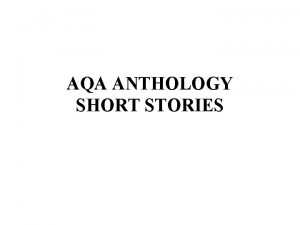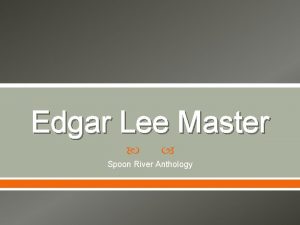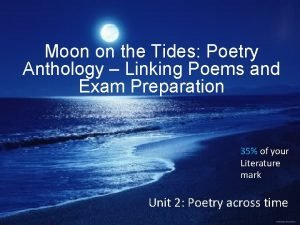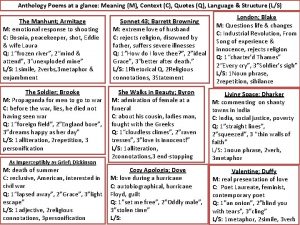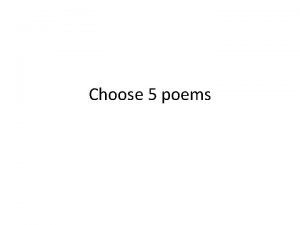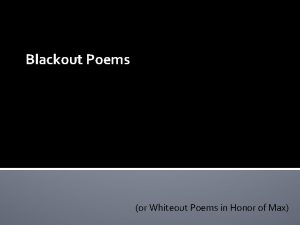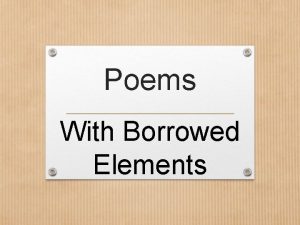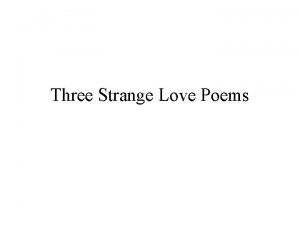Anthology Poems in a nutshell My Las t


















- Slides: 18

Anthology Poems (in a nutshell) My Las t Du che Th ss e. E mi gre e s e n g i r a ha r m t. C e e e ry R ne issu raph o t s i H e ayo nd T tog e m z ut e o a a o r B de l g a g u n h i s i r k s I k B i he ar P xpo. Chec he Light mon t W es E arge of t a Krm ias oppi The Ch de Sto andond. Pon The Prelu L O m y z

Kamikaze GARLAND Context • Japanese Kamikaze pilots flew planes into US war ships in WW 2. • It was a great honour to be a Kamikaze Pilot. Form and Structure • Title gives us indication of the context. • Written from a dual perspective – italics signify granddaughter and normal text omniscient narrator. Themes Nature Conflict Loss/absence Identity Memory Personal conflict Language • Natural imagery “shoals of fishes flashing silver” with sibilance represents softness of home. • Listing at start reflects orders given “flask of water, a samurai sword” • Symbolism “figure of eight” infinity. • “One-way journey into history” • “No longer the father we loved”

Poppies WEIR Context • Writer was a textile designed – fabric imagery. • Writer is a mother herself. Form and Structure • Use of time indicators “Three days before” • Regular stanza/ line length alongside use of enjambment and caesura shows she is trying to keep emotions together. Themes Nature Conflict Loss/absence Memory Identity Fear Personal conflict Language • Use of fabric imagery, texture to show the layers of her emotions “tucks, darts, pleats” • Symbolism of “songbird” to represent son. “Spasms of red” to represent violence of war. • “The dove pulled freely against the sky”

The Prelude WORDSWORTH Context • Poet lived in the Lake District – concerned with nature. • Parents, wife and three children all died early in life. Form and Structure • Part of a longer autobiographical ‘epic’ poem. • No stanzas make it seem like storytelling. • Starts peacefully but ends with a more tense atmosphere. Themes Nature Conflict Memory Fear Pride Personal conflict Language • Use of “and” makes it seem conversational. • Personification of nature “upreared its head” • Natural imagery changes from being peaceful to scary. • “a huge peak. Black and huge” • “a trouble to my dreams”

War Photographer DUFFY Context • Developing old photographs involved using lots of chemicals in a dark room to slowly reveal the image. • Poet was friends with war photographers. Form and Structure • Regular structure of stanzas and rhyming shows how photog. tries to put order into chaos of war. • 3 rd person narrative distances us from photographer. Themes Conflict Memory Anger Guilt Personal conflict Language • Emotive language used to show troubled memories “spools of suffering” • Plosive sounds “Beirut. Belfast” click of camera or explosions? • “blood stained into foreign dust” • “They do not care”

London BLAKE Context • Poet concerned with how the industrial revolution had made poor people’s lives worse – inequality in society. • Rejected organised religion. Form and Structure • Strict ABAB rhyme scheme makes poem sound song like (from Songs of Experience book) • Four stanzas each show a snapshot of different people in the city. Themes Human power Loss and absence Fear Anger Pride Language • Repetition of “Chartered” (owned) “marks” • Negative words “woe” “fear” “cry” • Metaphor – “Mind-forged manacles” • Oxymoron – “marriage hearse” • Violent imagery “runs in blood” “blights with plagues”

My Last Duchess BROWNING Context • Based on a real life duke (Alfonso II) in Italy who was rumoured to have killed his wife. • Poem is set in 1564 (3 years after her death) Form and Structure • Dramatic monologue – only one speaker shows Duke is in control. • Iambic pentameter and rhyming couplets make the speech seem prepared/rehearsed. Themes Human Power Memory Pride Identity Language • Enjambment - he does not want to hear any other opinion. • Personal pronouns – he is only concerned with himself and his possessions “I” “My” • “too soon made glad” • “I gave commands” • “nine-hundred year old name”

Remains ARMITAGE Context • Post Traumatic Stress Disorder – mental condition which effects many ex-service people. • About modern conflict (Iraq, Afghanistan) Form and Structure • Conversational tone “end of story, not really” • Enjambment and caesura emphasise natural speaking patterns of speaker. • First person narrative – telling us an incident. Themes Conflict Memory Guilt Personal Conflict Language • Juxtaposition of the horror of war with the every day “Dream – and he’s torn apart” • Use of anecdote and prosaic (everyday language) “legs it up the road” • “His bloody life in my bloody hands”

The Emigree Themes RUMENS Loss /Absence Identity Context Memory • Poet born and brought up in London (a multi- Personal Conflict cultural environment) • About modern conflict and immigration from countries involved in conflict or tyranny. Form and Structure • 3 stanzas each of which end with the repeated image of “sunlight” • No consistent structure or rhyme to show her uncertainty. Enjambment. • First person narrative – she is telling a story. Language • Childish images “a hollow doll” contrasted with dark imagery “mutter death” • Anecdotal “There once was” • Personification of the city “sick with tyrants” • Innocent symbolism “white” • “Time rolls its tanks”

The Charge of the Light Brigade TENNYSON Context • Battle of Balaclava was a real battle in the Crimean War where there was a great loss of life due to poorly considered orders. • Poet was the poet laureate. Form and Structure • Strong rhythm reflects the sound of galloping horses. • Repetition of “six hundred” “cannons” • Six stanzas reflect 600 men who died. • Structure breaks down towards poem end. Themes Human Power Conflict Loss Anger Language • Military imagery “cannons” “guns” “sabres” • Biblical allusion “Valley of death” • Alliteration used to reflect sound of shots “shot and shell” • “When can their glory fade? ” • “mouth of hell”

Ozymandias SHELLEY Context • Ozymandias refers to Pharaoh Rameses II • Shelley was anti-monarchy and against governments which thought they were invincible. Form and Structure • Sonnet form – but without simple rhyme scheme and not about love. • Two speakers (omniscient narrator and traveller) • One long stanza – reflects storytelling. Themes Power of Nature Human Power Pride Language • Alliteration reflects nothingness of the desert “lone and level” “boundless and bare” • Repetition used to show Ozymandias’ arrogance “King of kings” • “Sneer of cold command” • “Colossal wreck”

Exposure OWEN Context • Poet was a soldier in WW 1 and died in battle. Themes Power of Nature Conflict Loss and absence • He was very critical of those in charge during war and felt war was pointless. Form and Structure • Repetition of hopeless statements (“But nothing happens”) as half lines at the end of each stanza. • Present tense makes us feel their hopelessness. • Para-rhymes give an uncomfortable feel. “faces” and “fusses” Language • Personification of weather to make it seem like the enemy “winds that knife us” • Sibilance to reflect the sounds of war “sudden successive flights of bullets” • Pathetic fallacy – “clouds sag stormy” • “Our brains ache”

Storm on the Island HEANEY Context • Poet grew up in rural island. Themes Power of Nature Human Power Fear • References the “troubles” in Ireland – Stormont is the Northern Ireland Government building Form and Structure • Conversational tone using blank verse with no rhyme and one long stanza. • Present tense makes us feel within the storm. • End – “It is a huge nothing that we fear” – suggests more to be feared than just the storm. Language • War imagery “salvo” “bombarded” makes the weather sound attacking. • Simile – “like a tame cat turned savage” • Sibilance creates the sound of the wind “dives and strafes invisibly” • “exploding comfortably”

Bayonet Charge HUGHES Context • Poet briefly served in the RAF before going to Cambridge University. Themes Conflict Fear Personal conflict • About trench warfare – going “over the top” Form and Structure • Begins ‘in media res’ (“suddenly he awoke”) with soldier following orders. • As the poem progresses the soldier begins to question why he is fighting. • Line lengths vary to make the poem begin quickly and then slow down. Language • Natural imagery contrasts war “green hedge that dazzled with rifle fire” • Hare represents what will happen to the soldier “its mouth wide open silent” • Listing gives patriotism less meaning “king, honour, human dignity, etc”

Checking Out Me History AGARD Context • Poet born in the Caribbean and moved to the UK in the 1970 s. Themes Human Power Anger Personal conflict • Writes to reflect his real speech “Dem tell me” Form and Structure • First person voice of the poet speaking directly to the reader. • Two structures with different fonts and rhyme schemes – what he is told Vs. his own history. • Repeated phrases reflect repetition of what he is told. Language • Nursery rhyme references show what English history means to him “Old King Cole” • Light imagery linked to black heroes “beacon” “star” “firewoman” • Natural imagery linked to black heroes “freedom river” • “I carving out me identity”

Tissue DHARKER Context • Poet has Pakistani origins but born in Glasgow. • She is interested in global issues, terrorism, religion and identity. Form and Structure • Written as an ongoing monologue. • No real rhyme, rhythm, structure reflects the transience and movement of tissue, as well as how she would like the world to be. Themes Power of Nature Human Power Pride Identity Language • Extended metaphor of paper represents the fragility of the modern world. • References to everyday objects “koran” “grocery slips” – symbols of wider issues in the world • Natural imagery “sun shines through”


Tissue Poppies Ozymandias The Prelude Remains Nature Bayonet Charge War photographer r a w Kamikaze The Charge of the Light Brigade Me mo e London pla c My Last Duchess Exposure The Emigree ry Storm on the island Checking out me history
 Anthology poems
Anthology poems Web design in a nutshell
Web design in a nutshell Self-attention
Self-attention James webb telescope
James webb telescope Tenses in a nutshell
Tenses in a nutshell Itil in a nutshell
Itil in a nutshell Grammar in a nutshell
Grammar in a nutshell Photosynthesis in a nutshell
Photosynthesis in a nutshell Bfs in a nutshell
Bfs in a nutshell Zootopia rules
Zootopia rules Apa in a nutshell
Apa in a nutshell The eatonville anthology analysis
The eatonville anthology analysis Norton anthology victorian age
Norton anthology victorian age Between a rock and a hard place language techniques
Between a rock and a hard place language techniques Norton anthology of western literature
Norton anthology of western literature Introduction on love
Introduction on love Eduqas poetry anthology
Eduqas poetry anthology Aqa a level english literature b poetry anthology
Aqa a level english literature b poetry anthology![[anthology] lq -little queen- vol. 40 [digital] [anthology] lq -little queen- vol. 40 [digital]](data:image/svg+xml,%3Csvg%20xmlns=%22http://www.w3.org/2000/svg%22%20viewBox=%220%200%20200%20200%22%3E%3C/svg%3E) [anthology] lq -little queen- vol. 40 [digital]
[anthology] lq -little queen- vol. 40 [digital]
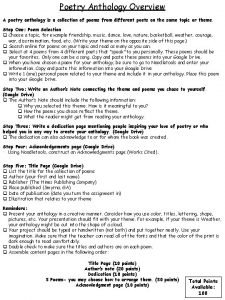

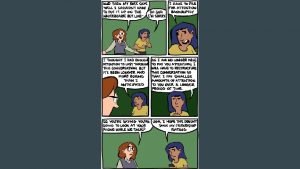
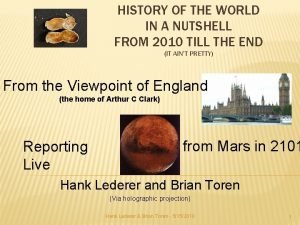
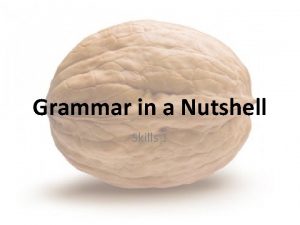

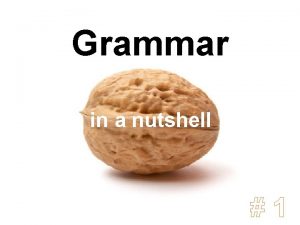
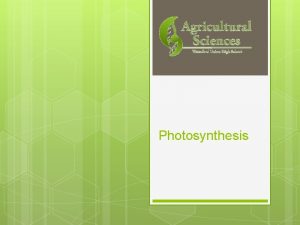
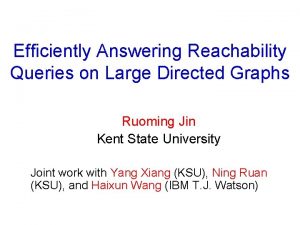
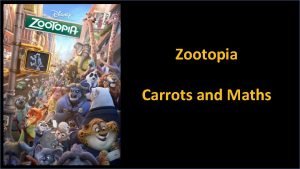

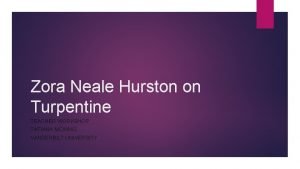
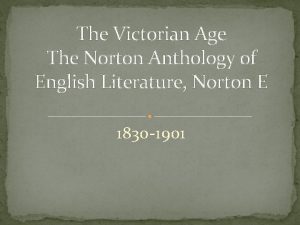
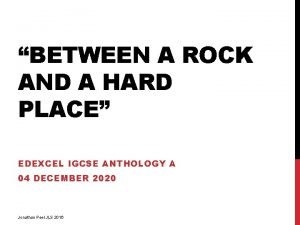
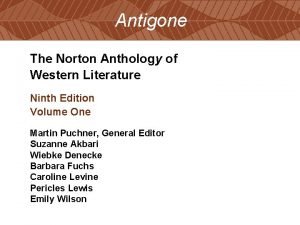
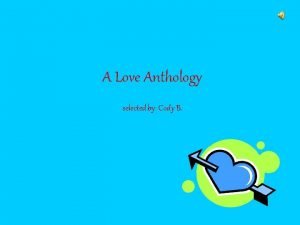
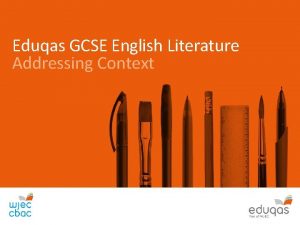
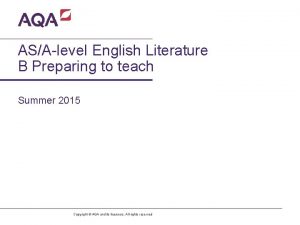
![[anthology] lq -little queen- vol. 40 [digital] [anthology] lq -little queen- vol. 40 [digital]](https://slidetodoc.com/wp-content/uploads/2020/12/3346623_ae8474c31416d58beb43272c3ea4efb2-300x225.jpg)

